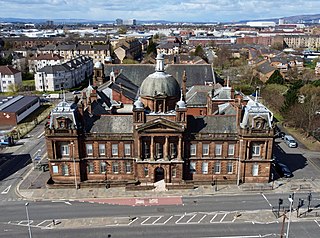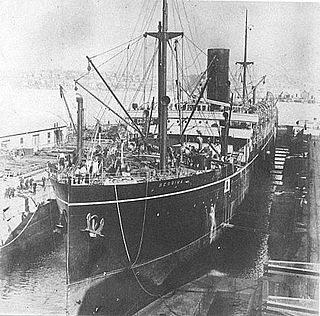Related Research Articles

Govan is a district, parish, and former burgh now part of southwest Glasgow, Scotland. It is situated 2+1⁄2 miles west of Glasgow city centre, on the south bank of the River Clyde, opposite the mouth of the River Kelvin and the district of Partick. Historically it was part of the County of Lanark.

Kinghorn is a town and parish in Fife, Scotland. A seaside resort with two beaches, Kinghorn Beach and Pettycur Bay, plus a fishing port, it stands on the north shore of the Firth of Forth, opposite Edinburgh.
Crichton may refer to:

The Fairfield Shipbuilding and Engineering Company, Limited, was a Scottish shipbuilding company in the Govan area on the Clyde in Glasgow. Fairfields, as it is often known, was a major warship builder, turning out many vessels for the Royal Navy and other navies through the First World War and the Second World War. It also built many transatlantic liners, including record-breaking ships for the Cunard Line and Canadian Pacific, such as the Blue Riband-winning sisters RMS Campania and RMS Lucania. At the other end of the scale, Fairfields built fast cross-channel mail steamers and ferries for locations around the world. These included ships for the Bosporus crossing in Istanbul and some of the early ships used by Thomas Cook for developing tourism on the River Nile.

William Denny and Brothers Limited, often referred to simply as Denny, was a Scottish shipbuilding company.

Scotts Shipbuilding and Engineering Company Limited, often referred to simply as Scotts, was a Scottish shipbuilding company based in Greenock on the River Clyde. In its time in Greenock, Scotts built over 1,250 ships.

Palmers Shipbuilding and Iron Company Limited, often referred to simply as "Palmers", was a British shipbuilding company. The company was based in Jarrow, County Durham, in north-eastern England, and had operations in Hebburn and Willington Quay on the River Tyne.
Kinghorn may refer to:
Lithgows Limited is a family-owned Scottish company that had a long involvement in shipbuilding, based in Kingston, Port Glasgow, on the River Clyde in Scotland. It has a continued involvement in marine resources.
Scott Lithgow, Limited was a Scottish shipbuilding company.
Douglas may refer to:
Fleming and Ferguson was a Scottish marine engineering and shipbuilding company that traded between 1877 and 1969.

A steam yacht is a class of luxury or commercial yacht with primary or secondary steam propulsion in addition to the sails usually carried by yachts.

HMHS Lanfranc was a Booth Line passenger steamship that was built in Scotland in 1907 and operated scheduled services between Liverpool and Brazil until 1914. In the First World War she was a hospital ship until a U-boat sank her in the English Channel in 1917.

Caird & Company was a Scottish shipbuilding and engineering firm based in Greenock. The company was established in 1828 by John Caird when he received an order to re-engine Clyde paddle-tugs.

David & William Henderson and Company was a Scottish marine engineering and shipbuilding company, based on Clydeside. It was founded in 1872 and traded until 1936. Its shipyard was on the north bank of the River Clyde at its confluence with the River Kelvin.
HMAS Orara was a coastal passenger and cargo steamship that was built in Scotland in 1907 and sunk by a mine in China in 1950. She spent most of her career in the fleet of the North Coast Steam Navigation Company (NCSNC) of New South Wales. In the Second World War she was an auxiliary minesweeper and depot ship in the Royal Australian Navy.

Horace See was an American mechanical engineer, marine engineer, naval architect, inventor, and superintendent. He is known as principal naval architect at the William Cramp & Sons shipyard in Philadelphia, and as president of the American Society of Mechanical Engineers in the year 1888–89.
PS Rouen was a passenger ferry that was built in Glasgow in 1888 for the London, Brighton and South Coast Railway (LB&SCR). In 1903 she was acquired by JP and RP Little for the Barrow Steam Navigation Company and renamed Duchess of Buccleuch. In 1907 she passed to the Midland Railway, and in 1909 she was scrapped.

Rankin & Blackmore Ltd was a Scottish firm of marine engine makers. The firms origins lie in the purchase of the Johnstone and Leitch's Eagle Foundry in Greenock in 1862 by Daniel Rankin and Edward Blackmore. The firm was incorporated in 1914 and was bought by Lithgows in 1923. The firm closed in the 1960s going into voluntary liquidation in 1967.
References
- ↑ "Scott of Kinghorn". Grace's Guide: The Best of British Engineering 1750–1960s. 27 June 2012. Retrieved 15 February 2015.